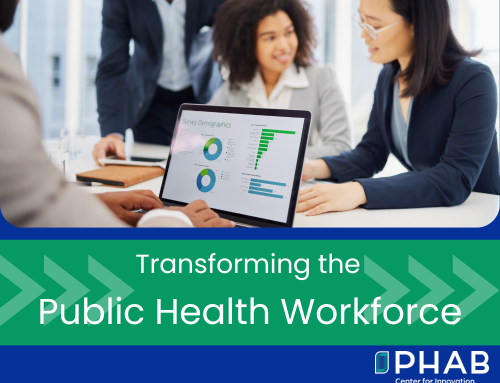The Foundational Public Health Services (FPHS) Framework outlines the unique responsibilities of governmental public health and defines a minimum set of Foundational Capabilities (FCs) and Foundational Areas (FAs) that no community should be without. The FPHS serves as the backbone for infrastructure improvement and transformation efforts by providing a framework by which health departments and health department systems can describe the vital role of governmental public health in a community, identify capacity and resource gaps, determine the cost for assuring the delivery of foundational activities, plan and innovate to build on the Foundational Capabilities and Areas, and justify needs. 
PHAB is the home of the national FPHS Framework and provides a variety of tools and resources to support implementation. If you have been thinking about how to integrate the FPHS into your infrastructure improvement and transformation efforts but aren’t sure where to start, we have provided some initial steps and supplemental resources below. Additionally, while the integration of the FPHS Framework can occur within an individual health department, we recommended that health departments work together as a system to ensure that a minimum package of services is available across a geographic area. This system-level approach may include local and/or tribal health departments working in tandem with the state health department and/or alongside key public health partners like a state’s association of city and county health officials (SACCHO).
Getting Started
- Familiarize yourself with the FPHS Framework. The Framework, most recently updated in 2022, is comprised of eight Foundational Capabilities (infrastructure) and five Foundational Areas (programs). The FPHS Factsheet is a helpful resource as it provides detailed definitions of the public health infrastructure and program activities required for health departments to provide basic protections to the communities they serve. Additionally, updated FPHS self-study training modules will be available in October, at no cost, through the PHAB Learning Center.
- Use the FPHS Planning Guide. This guide provides health departments and health department systems with key components to consider in the FPHS implementation process. The document begins with a brief overview of the FPHS Framework, its role in infrastructure improvement and system transformation, then walks users through a series of planning components that address topics such as convening leadership, inventorying strengths and challenges, assessing motivations and support for change, establishing a leadership council or team, identifying policy considerations, ensuring availability of resources, assessing current capacity and cost, identifying solutions to address gaps, establishing a plan of action, and communication.
- Adopt and apply the FPHS Framework to your system. Systems are strongly encouraged to adopt the FPHS Framework, as designed, to support shared understanding, communication, consistency, and comparability of data related to strengths, gaps, capacity, and cost across health department systems nationally. Some states have found it helpful to hold discussions around each of the FCs and FAs to increase awareness of how the infrastructure and programmatic activities play out within the system. This increases shared understanding of the Framework, provides additional clarity around which activities are/are not considered foundational, fosters system-level alignment, and serves as a jumping off point for future visioning, assessment, and planning efforts. Additionally, system partners should identify who is part of their governmental public health system in their state (ex. Local HDs, Tribal HDs, State HDs, Board of Health, etc.), develop a vision for what a transformed public health system would look like if 100% of the FPHS were available to all residents in all communities, and identify gaps in the delivery of foundational activities.
- Use assessment tools to understand current gaps in FPHS implementation. PHAB has several tools that can be used to gather data related to the delivery of foundational activities including the FPHS Capacity & Cost Assessment, Workforce Calculator, and Readiness Assessment. These tools can be used independently or in conjunction with one another to assess the extent to which FPHS are available in a community, assess the current capacity (staffing/expertise) and cost associated with the delivery of foundational activities, as well as establish estimates of future capacity and cost needs. The resulting data informs overall planning efforts, can be used to advocate for necessary resources (staffing, sustainable funding), and can help identify strategies and innovative solutions to address identified gaps.
- Learn from other states. PHAB coordinates a 21st Century Learning Community currently comprised of 18 member states who are engaged in intentional state-wide system transformation efforts. The Learning Community provides space for peer networking, sharing, and learning. Summaries of transformation work occurring in 21C states can be accessed using the link above. State-systems who are using the FPHS to transform their public health system may be eligible for 21C.
While the suggestions above are intended as a place to start, there are other PHAB resources available to assist health department and health departments systems in their ongoing FPHS and transformation work including, but not limited to, Pathways Recognition Program, Accreditation, Service and Resource Sharing, and Moving into Equity Guide.
For more information or inquiries
If you have additional questions, would like more information, are interested in additional training, or would like to strategize with a PHAB Center for Innovation staff member on approaches that would best meet the unique needs of your department or system, please reach out to the PHAB Center for Innovation at [email protected].
Author:
Naomi Rich, Program Specialist at [email protected].



